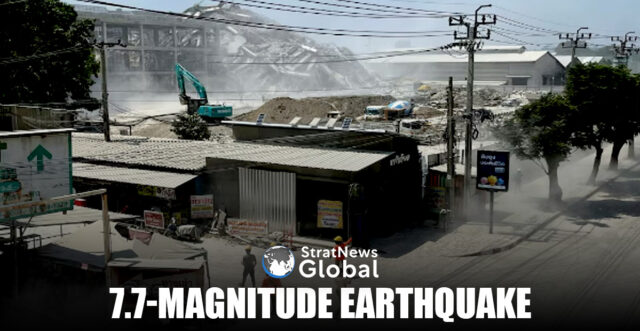A powerful earthquake struck central Myanmar on Friday, sending tremors as far as Bangkok, where panicked residents fled buildings.
The United States Geological Survey (USGS) said the quake was of 7.7 magnitude and at a depth of 10 km (6.2 miles). It was followed by a powerful aftershock.
The epicentre was about 17.2 km from the city of Mandalay, which has a population of about 1.2 million, according to USGS.
There was no immediate word on damage or casualties from Myanmar, which remains in the midst of a civil war.
Search And Rescue Ops Underway
An officer from the Myanmar Fire Services Department told Reuters: “We have started the search and are going around Yangon to check for casualties and damage. So far, we have no information yet.”
Social media posts from Mandalay showed collapsed buildings and debris strewn across streets. Reuters could not immediately verify the posts.
Witnesses contacted in Yangon said many people ran out of buildings in the city, the largest in the country.
Panic In Bangkok
As the earthquake struck, alarms blared in buildings, prompting startled residents to evacuate via staircases from high-rise condominiums and hotels in central Bangkok.
Greater Bangkok area, home to over 17 million people, has a large population residing in high-rise apartments.
Many gathered in the streets, seeking shade from the midday sun in the moments following the tremors.
Witnesses in Bangkok said people ran out onto the streets in panic, and water splashed out of swimming pools.
There were no immediate reports of damage or casualties. However, the quake’s intensity caused water to spill from rooftop pools as buildings shook.
Tremor Felt In India
Tremors were felt in India’s Delhi-NCR and other parts of the country, according to local media reports.
Earthquake-Prone Myanmar
Earlier on March 9, a 4.3-magnitude earthquake struck Myanmar at a depth of 125 km, according to the National Centre for Seismology. Just days earlier, on March 3, another earthquake of magnitude 4.2 was reported in the region.
Shallow earthquakes, like these, tend to be more destructive than deeper ones as they release more energy closer to the surface, leading to stronger ground shaking and greater structural damage.
Despite being highly earthquake-prone, Myanmar lacks an official national seismic hazard map.
The country sits in a high-risk seismic zone due to the ongoing collision between the Eurasian and Indo-Australian plates.
Data from the International Seismological Centre indicates that Myanmar and its surrounding areas experience approximately 140 earthquakes of magnitude 3.0 or higher each year.
This seismic activity poses significant risks, including potential tsunami threats along Myanmar’s extensive coastline.
(With inputs from Reuters)





